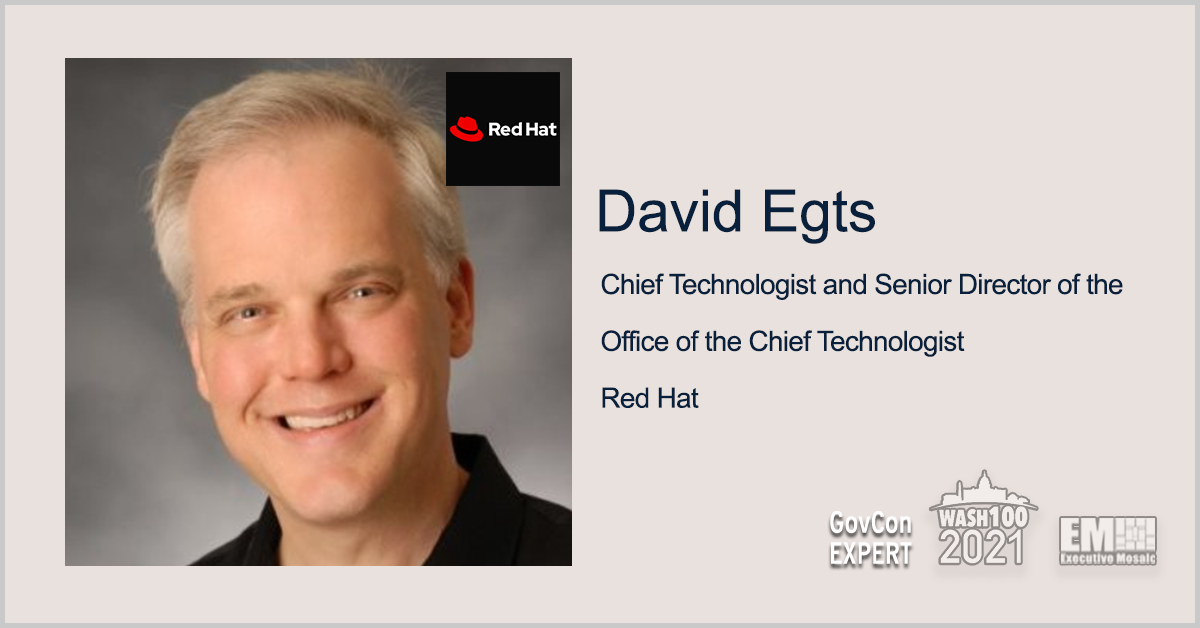David Egts, chief technologist and senior director of the Office of the Chief Technologist for Red Hat’s North America Public Sector, has published his first article as a part of Executive Mosaic’s GovCon Expert program on Thursday.
In his first piece, GovCon Expert David Egts provided a breakdown looking into the impact that the COVID-19 pandemic has made on the digitization of federal agencies as well as the crucial lessons that government contractors should take away from these initiatives to be successful in the future.
You can read David Egts’ full GovCon Expert article below:
Putting People First: Three Things I Just Learned About Government Digitization
By GovCon Expert David Egts
The COVID-19 pandemic significantly accelerated digitization initiatives at all levels of government, including federal, state, and local agencies. As a contractor, you likely felt this acceleration, resulting in a greater demand for solutions that support your customers’ desires to use technology to connect with citizens. But how are they leveraging technology, and to what end?
That was the focus of a recent panel I hosted featuring Chaeny Emanavin of the State of California’s Health and Human Services Agency, Steve Harding from the General Services Administration, and Aaron Judy of the Maricopa County (Arizona) Clerk of the Superior Court.
They gave me some key insights into the kinds of technologies agencies are looking for to improve customer service, which happens to be a key cornerstone of the Biden administration’s vision and number two on NASCIO’s “State CIO Top Ten Policy and Technology Priorities for 2022”.
Put Accessibility and Equity First
The conversation started with an introduction that I’ve never experienced in my decades of public speaking and completely took me aback. When I introduced Steve Harding, instead of giving the usual background about his role and responsibilities, he described his physical appearance, his location, and other details to connect with visually-impaired viewers.
This approach made me aware of my own assumptions and biases despite regarding myself as a consciously inclusive and well-meaning individual. Also, Steve was making a broader point: as public servants, government leaders need to communicate with everyone, regardless of ability, language, economic background, and other factors. I highly recommend watching it, as it gives a valuable lesson about unconscious biases and things we may take for granted.
Indeed, federal and state and local agencies are focused on delivering services in the most equitable and accessible ways possible. Accessibility needs to be intentional. That could mean different things depending on the offering.
For example, a site might include descriptions of images for the visually impaired, videos with secondary audio tracks that describe what’s happening on the screen, or a feedback loop to catch and respond to citizens’ feedback and oversights is critical.
Key learning: Agencies want applications with accessibility and equitability baked in so they can better communicate and interact with all constituents.
Convey Empathy with AI
Engendering trust between agencies and citizens requires an understanding that’s sometimes difficult to achieve through a screen. And yet, as citizen services become more digitized, conveying empathy will still be important to ensure that government services don’t lose their human touch.
Aaron Judy discussed using AI to emulate empathy, compassion, and understanding. As machines become more intelligent, they’ll be able to automate responses to requests more efficiently. And since the drive for efficiency should not be so ruthless that it crowds out the human element, machines will need to evolve to react to those requests in real-time and replicate emotions found in normal human interactions.
As the private sector continues to develop its own AI centers of excellence, we need to make sure our applications make government service more efficient. We must always remember that we’re developing solutions for people from all demographics and strive to make these solutions easy and satisfying to use.
Key learning: Government agencies want technologies that reinforce the human element of the government/citizen relationship.
Build and Nurture the Workforce of the Future
Neither of these innovations could take place without a workforce that’s highly skilled in new technologies and open to different ways of thinking. It’s clear to me that the leaders I spoke with are focused on creating that workforce, particularly by investing in and training IT talent. They have programs in place to help employees learn new skills to help them design and build digital services faster using modern technologies.
As they implement those technologies, government leaders are actively seeking input from employees. Chaeny Emanavin noted that they routinely survey small groups of users to offer input on the tools they prefer.
Perhaps unsurprisingly, they often hear that employees want solutions that are easy to use and accessible–just like the citizens they’re serving. This is an important reminder that government employees are end customers, too, and need solutions that are simple to navigate and user-friendly
This is especially important now, when many government agencies are dealing with staff shortages. All of us in industry must employ our expertise and the lessons we’ve learned working with other customers to help our clients manage technological change within their organizations.
Key learning: Ease of use is just as important for government users as it is for citizens.
These are just a few of the takeaways from the discussion, but we covered a lot more, including automation, and journey mapping. For these and other insights, check out the full session. It proves that, when it comes to digitizing government services, it’s important to always lead with the human element.





